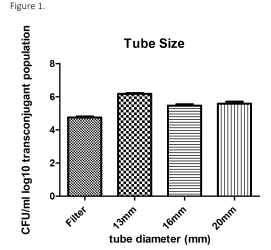Project Summary
Determination of Factors Affecting Frequency of Conjugative Transfer of Antimicrobial Resistance and Virulence
- Principle Investigator(s):
- Toni L. Poole and Todd R. Callaway
- Institution(s):
- USDA-ARS
- Completion Date:
- May 2014
Background
E. coli and Salmonella are a concern to the food production industry. Both possess combination of antimicrobial resistance and virulence genes that act in concert with undefined host factors, to gain an advantage over beneficial bacteria. In order to understand factors involved in the dissemination of multi‐drug resistance (MDR) among E. coli and Salmonella, it is necessary to study the relationship between antimicrobial resistance and disease-causing genes, as well as their ability to transfer between bacteria. The relationship of other host factors must also be considered and examined.
The objectives of this study were to: 1) evaluate the association between multiple‐drug resistance (MDR) and virulence in E. coli and Salmonella, 2) evaluate compartment proximity on conjugative frequency, and 3) evaluate the effect of pH and dissociated organic acids on conjugative frequency.
Methodology
One hundred each of 1) Multiple‐drug resistant Salmonella (MDRS); 2) Multiple‐drug resistant E. coli (MDRE); 3) pan-susceptible Salmonella (PSS); 4) pan-susceptible E. coli (PSE) from beef and dairy cattle were pheno‐ and genotypically characterized for content of antimicrobial resistance and virulence genes. Conjugation and transfer of the resistance and virulence genes were evaluated. All MDR isolates were used as potential gene donors capable of transfer of resistance and virulence genes and all PS isolates as potential recipients of genes. To evaluate the cell proximity on the frequency of conjugative transfer, test tubes of different diameters were used in the conjugation experiments.
To investigate the effect of pH on the frequency of conjugative transfer, a donor and recipient pair were used in conjugation experiments at different pHs. This was done in a pH range similar to the bovine gut. Additionally, to evaluate dissociated organic acid toxicity found in the gastrointestinal tract the same donor and recipient pair were used in conjugation experiments with different mM concentrations of acetic acid, propionic acid and butyric acid.
Findings
First, the pan-susceptible E. coli and Salmonella possessed higher numbers of virulence genes the multi‐drug resistant isolates did and had a higher incidence of being conjugative (being able to receive resistance plasmids) than the MDR E. coli and Salmonella did of transferring resistance plasmids. Second, the potential diameter of the gastrointestinal tract may play a role in the ability of bacteria to conjugate and transfer resistance genes,
Implications
The use of antibiotics provides a selective advantage for MDRE and MDRS bacteria. Additionally, isolates that possess virulence genes may also have a selection advantage. Therefore, it is possible that the PSS isolates with virulence traits may be present in the gut simultaneously with the MDR isolates. This might increase the likelihood that virulent strains may have a greater opportunity to acquire resistance than harmless commensals. The results show that a small diameter may be a benefit with regard to cattle in that they have a considerably larger intestinal tract than other species.
Table 1. Incidence of E. coli Virulence Genes.
|
Virulence genes |
stx1 (n =) |
stx2 (n =) |
eaeA (n =) |
hlyA (n =) |
saa (n =) |
|
MDRE n = 100 |
3 |
8 |
8 |
2 |
0 |
|
trMDRE n = 27 |
0 |
0 |
0 |
0 |
0 |
|
PSE n = 100 |
9 |
11 |
40 |
41 |
0 |
trPSE was the same as PSE.
Table 2. Incidence of Salmonella Virulence Genes.
|
Virulence genes |
invA (n =) |
spvA (n =) |
rck (n =) |
|
MDRS n = 100 |
96 |
10 |
5 |
|
trMDRS n = 27 |
0 |
1 |
1 |
|
PSS n = 100 |
100 |
27 |
1 |
trPSE was the same as PSE.
